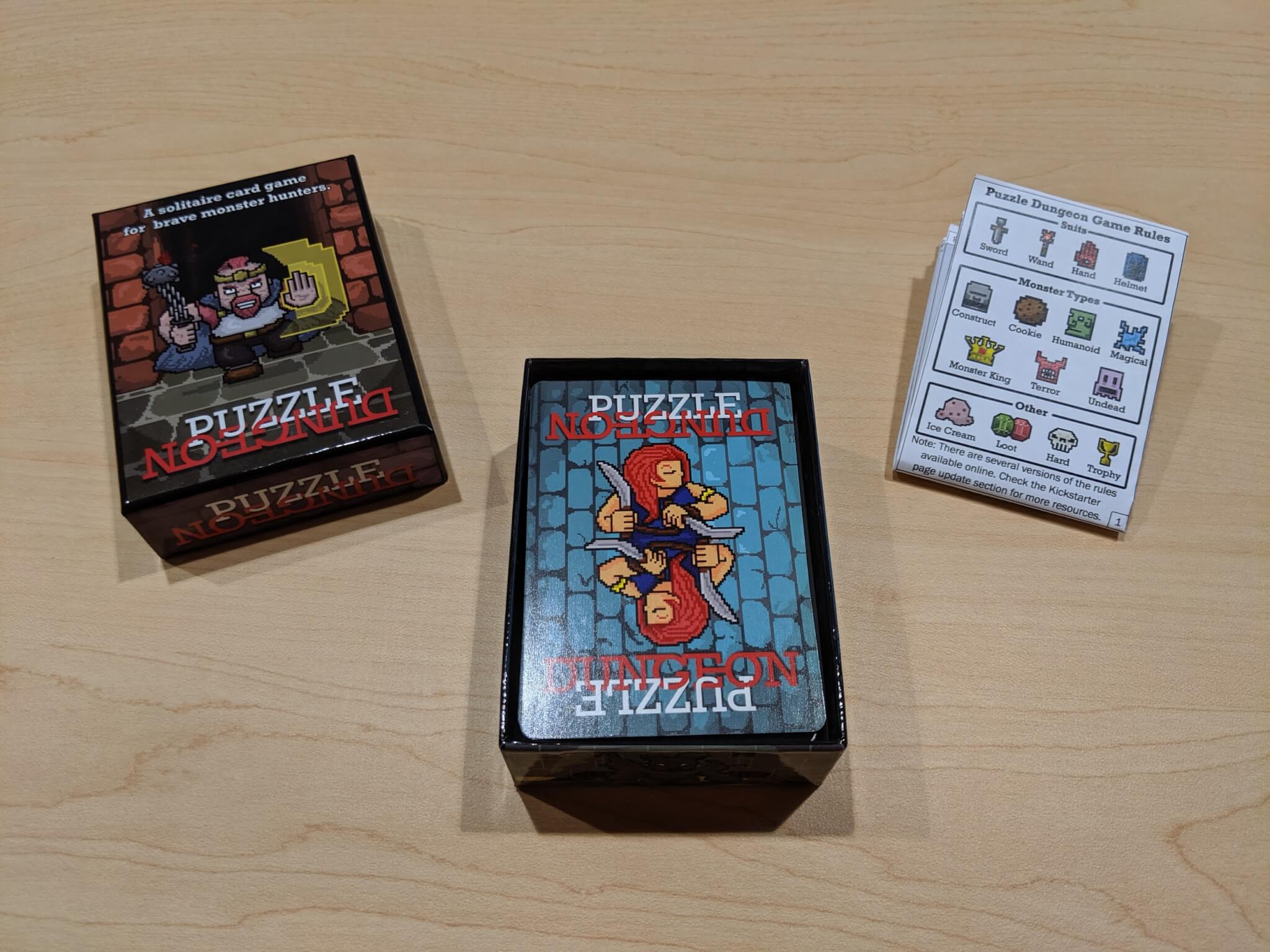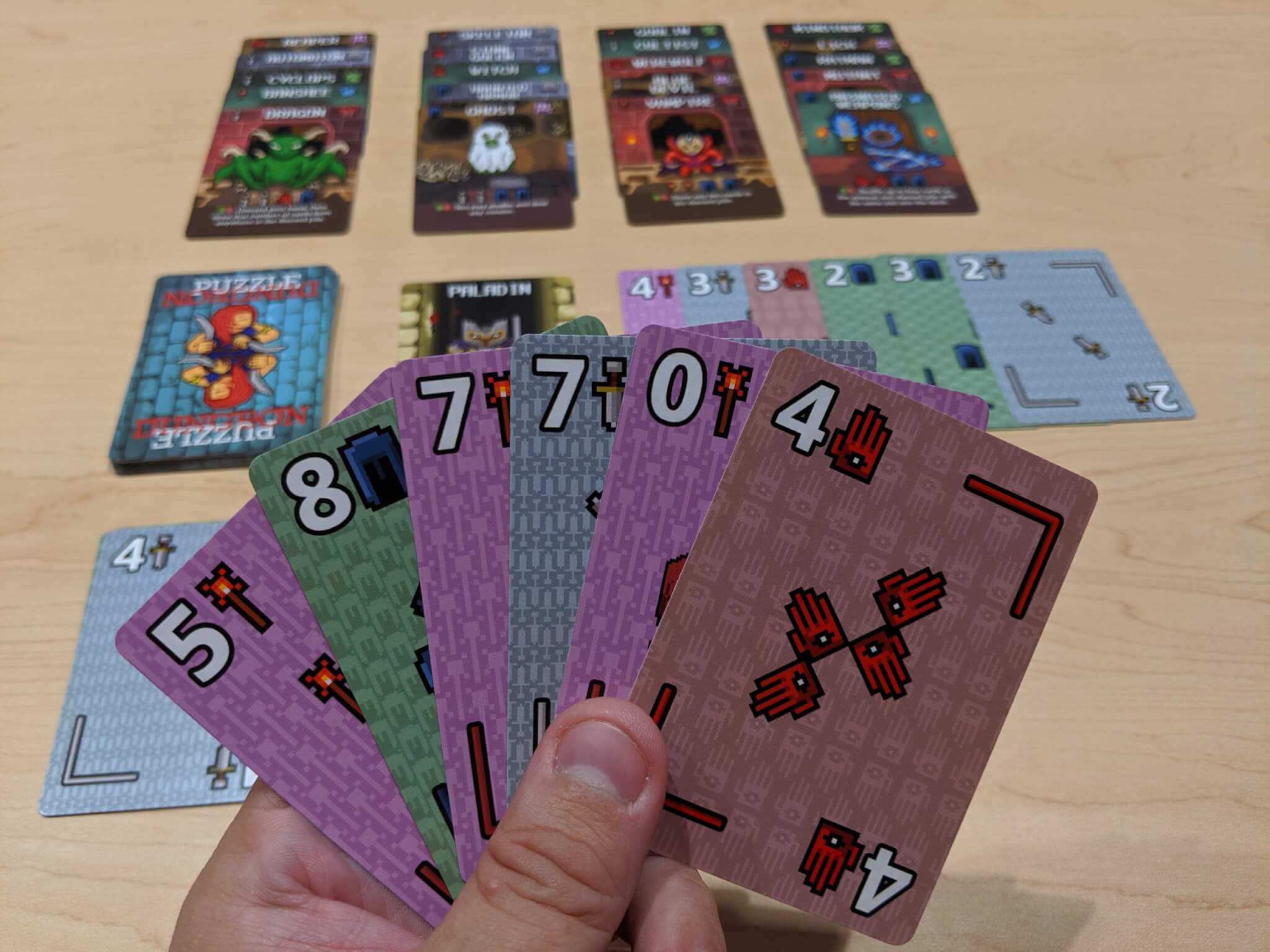![]() Puzzle Dungeon is a Solitaire-based dungeon crawler, where your hero must slay certain types of monsters to triumph.
Puzzle Dungeon is a Solitaire-based dungeon crawler, where your hero must slay certain types of monsters to triumph.
I’ve never seen such a clever mechanic before that allows you to utilize the Solitaire format to defeat monsters, but here we are. Puzzle Dungeon has you working with a limited hand which is rarely replenished, adding to the challenge and reliance on the stacking seen in the classic card game to bring you to rely on a progression of cards that may very well seal your doom. Using what cards you’ve drawn, your arsenal and the monsters that you’ve defeated, you must kill the monsters in your bounty requirements from your carefully picked hero in order to win the game.
The box comes with a deck filled with Hero cards, double-sided Monster cards and Arsenal cards. Each card is decked out with classic pixel art — which reminds me a lot of classic dungeon crawlers that I used to play back in the eighties. There are eighty two cards in total and the game also comes with a handy visual rulebook, which helps a lot to quickly set up and play.

The set up of Puzzle Dungeon couldn’t be easier. You pick your hero from a wide assortment of job types and creatures, shuffle the monster and arsenal decks and then deal them out. All the monsters are then spread out in four columns of five monsters each. Next, you deal out six arsenal cards to the right of your deck — one stacked upon the next — and draw six cards to make your hand.
The trick to the game is using your hero’s abilities and the cards you have at your disposal to match all of the symbols on a monster’s card in order to defeat them. Your hero card lists their particular prey on the front of their card, along with their abilities and ‘trophy’ actions. You have to defeat all the prey listed on the card in order to win, so it takes a good deal of strategizing to figure out the proper way to attack your way through the ranks of enemies on the play field.
You can only pick up cards to attack from the arsenal — depending on how each card is stacked, so you can only draw from your arsenal in its order and you can only attack the monsters in front. Heroes are able to either draw or attack on their turn, and drawing means to reveal an additional card to place on the top of the arsenal cards; there are no limits on how many cards you may draw, but run out of cards and it’s game over. You may not draw to your hand unless your hero’s ability or an enemy’s ability tells you to, so you have to balance out to make sure you only play from your hand when absolutely needed.
Attacking is the meat of the game, but to say that you need only match the monster’s symbols is a broad simplification of the mechanics. To be able to attack, you must discard cards either from your hand or the arsenal and use their suits to fully match the requirements of the enemy’s listed weaknesses. If you cannot fully meet these requirements, you are unable to attack and must find a way to do so, otherwise you must draw until you can. The system is smooth and as long as you save the cards in your hand for tricky situations, the flow of attacking and drawing works pretty well. It’s ultimately up to luck, but using your defeated monsters can help tip the scales in your favor.
After you defeat an enemy, you can then immediately use their abilities and then add it to your collection. These enemies each have their own suits and can be used — by exhausting or turning the card to its side — just the same as a card from your hand or arsenal. Knowing when to utilize these monsters is a process by itself, but it’s nice to reap rewards from assassinating these menacing beasts. Additionally, you can seek out to kill monsters that are not on your prey checklist and earn what the game calls ‘trophies.’ Trophies allow you to use your hero’s trophy ability and may just be the extra oomph you need to turn the tide when the cards aren’t stacked in your favor.
If you find yourself having killed three of a particular monster type, you must flip the fourth monster of that type to its other side, revealing the monster king — its ability activates immediately. Some of the monster king’s effects can be devastating, so it’s important to plan your attack well in order to avoid it till the very end, if possible.
Puzzle Dungeon is a blast to play and it’s nice to have the option to play the game with a harder difficulty if you find the normal experience too easy. Flipping over the hero card to the side adorned with a skull in the corner introduces this harder challenge, and typically the abilities bring doom and hardship upon your hero. Having multiple options with play and the randomness of simply drawing ensures you’re going to have a new experience each time.
The heroes are as fun to look at as they are to play, with each one having a unique regular and trophy ability. The game makes good use of the simplicity of play to ensure quick playthroughs and you never feel like you are simply ‘out of options’ like one might expect to feel, given the Solitaire-similar stacking play and rules. Since it’s a single-player game, it’d be easy to carry with you if you ever feel like you want to get a quick round in, seeing as the full box could easily fit in a pocket or bag. Pixel art design is typically hit or miss, but I feel like the art in Puzzle Dungeon falls somewhere floating in the middle. Some of the cards look great and some seem a bit contrived, with less detail or just unnecessary spontaneity. I’m sure this is due to some of the cards being designed as Kickstarter rewards, but I feel that a little bit more care could have been taken to ensure additional details were added to cement some believability of the cards that you are basing your entire dungeon delve upon. Anyone who appreciates the charm of a classic art style will find something to love, from the whacky monster designs to the seemingly Commodore Amiga-style hero designs from the RPGs of old.
Pixel art design is typically hit or miss, but I feel like the art in Puzzle Dungeon falls somewhere floating in the middle. Some of the cards look great and some seem a bit contrived, with less detail or just unnecessary spontaneity. I’m sure this is due to some of the cards being designed as Kickstarter rewards, but I feel that a little bit more care could have been taken to ensure additional details were added to cement some believability of the cards that you are basing your entire dungeon delve upon. Anyone who appreciates the charm of a classic art style will find something to love, from the whacky monster designs to the seemingly Commodore Amiga-style hero designs from the RPGs of old.
I enjoyed the time I spent with Puzzle Dungeon — from the interesting art design and card abilities to its simple to play but difficult to master gameplay. Solo card games aren’t often found these days, but given Puzzle Dungeon’s inspiration, it makes sense and works well. I find the short time required to play a round refreshing and a perfect length due to the lack of intricate complexities in rules and card placements.
I feel that if you wanted to, you could work with a friend to try to figure out the best strategy in card play that might lead you to a faster victory; the invite to watch or play is an easy one, with colorful cards and pleasing aesthetics.
Puzzle Dungeon is now released and available, you can find out more information about the game on its Kickstarter page.
Love board games? Check out our list of the top board games we’ve reviewed.
 Puzzle Dungeon is a Solitaire-based dungeon crawler, where your hero must slay certain types of monsters to triumph.
Puzzle Dungeon is a Solitaire-based dungeon crawler, where your hero must slay certain types of monsters to triumph.